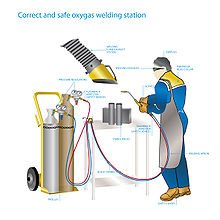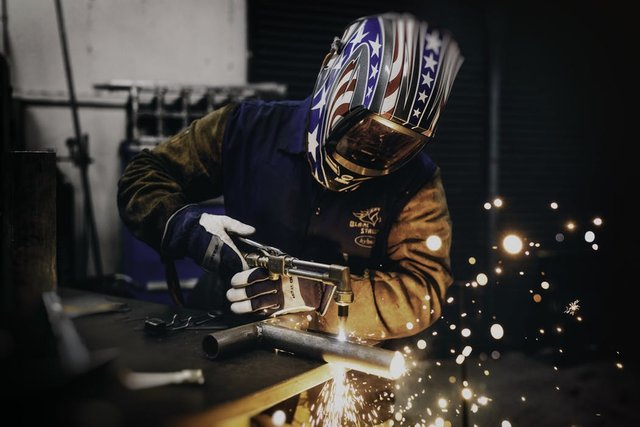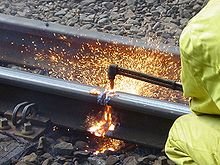I Want to Tell Us About Oxy-Fuel (Oxyacetylene) Welding and Cutting Operation
Hello, I Hope you all are fine and I welcome you to my blog once again and thanks for the constant encouragement.
Introduction
Oxy-fuel welding (commonly called oxyacetylene welding, oxy welding) and oxy-fuel cutting are processes that use fuel gases and oxygen to weld and cut metals, respectively. | Source
The oxyacetylene welding is suitable for pre-manufacture of steel sheet, tubes and plates. The oxyacetylene can be used for different operation like welding metals, cutting metals, heating metals etc.
Oxyacetylene gas welding is commonly used to permanently join mild steel. A mixture of oxygen and acetylene, burns as an intense / focussed flame. | Source
What makes up the oxyacetylene
Note that oxyacetylene and high pressure cylinders are very dangerous.
Oxygen:
Oxygen Gas filled in a cylinder are with pressure of 2000psi, approximately 140bar and obviously we can't work with such amount of pressure during the welding process of oxyacetylene welding, so we need a regulator. If you are observant, on the gas cylinder there is something like clock at the top, that is the regulator. This regulator has two gauges where one is closer to the valve that tells the pressure in the cylinder and the other tells the pressure coming into the hoses. Regulators are adjustable by turning the small lever attached to the regulator to change the working pressure as easy as that. Example of a normal pressure setting is 5psi which is approximately 0.35bar, like I wrote up you cannot work with the 2000psi from the cylinder directly.
Acetylene:
Apparently in the cylinder acetylene is not a gas as such but I can say it is a gas because it has dissolved into liquid more like a compressed gas like we see when filing our cooking gas, they pump in liquid substance mixture of butane and propane into the cylinder but we get gas as the output when it is been released to air. For the acetylene it is dissolved in acetone in form of liquid. Acetylene is unstable of above 18psi. checking the inside of an acetylene cylinder with an x-ray inspection tool you would see porous matrix, the matrix is filled with the acetone of about roughly 65% and the acetylene gas is dissolve into that acetone just like the CO2 is dissolve into coca cola before you open it and when you open the coca cola can, the CO2 escapes, that is a typical example of what happens with the acetylene and that it what keep the acetylene stable and also the more reason you should not use it on the side or use it while lying on the side, it should be settled overnight. Peradventure you must have used the acetylene upside down before, congratulations because you have been lucky, you should not do it because it is pretty dangerous. The acetylene cylinder also has a regulator but a little different in scale from the regulator on the oxygen cylinder because of the operating pressure and a typical setting of the regulator is 5psi of approximately 0.35bar.
Lets see the working of both
Acetylene and oxygen on their own can’t do the magic but when they are put together you see the magic.
A little of chemistry:
Acetylene is C2H2 while Oxygen is O2
Putting both together and burning them like an hydrocarbon we get carbon dioxide and water.
Balancing the equation we would have
The practical aspect of the above equation is to the proper ratio for combustion, for a complete combustion we need 2 parts of acetylene 2C2H2 and 5 parts of oxygen 5O2 as in the balanced equation to completely burn it. Now if we burn that proportion we get a Neural flame (a neutral flame produces carbondioxide CO2 and water H20), also it can be adjusted at the regulator to have excess of acetylene or oxygen and if there is excess oxygen you have a Oxidizing flame and if there is excess of acetylene you have Carburizing flame.
As stated in the introduction this process can be used for different operation like welding metals, cutting metals, heating metals etc.
The Welding Operation
For this operations there are different nozzles for each operation. This nozzle head has to nobs in which it is used to control the balance of the flame been given off for the operation. Now using a smaller nozzle for welding you have to drop the pressure at the pressure regulator, the working pressure depends on the top of the nozzle head and it depends on the job you are doing (the bigger the work, the bigger the tip an d the higher the pressure).
After getting the required pressure and everything is set, you can light up the tip using a spark not an open flame for safety reasons, for a start when you light up only the acetylene without the oxygen, there is going to be a Carburizing flame which would have a lot of carbon and if you are interested in the flame it is in 3 layers which are the outer layer, acetylene feather, and the smaller layer close to the nozzle tip and when you start opening the oxygen gradually those layer close up to form one which is the neural flame and that balances the equation.

Wikipedia CC 3.0 Licensed

Wikipedia CC 3.0 Licensed
At the stage where by all the layers are stable the flame stays at the tip because there is a flame front which is trying to burnt it way up the gas flowing through the hose, like lighting a fuse, first would run up the fuse. I mean there is a situation whereby the gas is coming out from the nozzle head and the flame is trying to get into the gas hose. If the pressure of the cylinder is too low or your gas cylinder is almost empty the flame might over power the pressure of the gas and then the flame comes into the nozzle and starts to burn it ways back to the fuse and to the cylinder but there is a solution for that which is flashback, the flashback breaks link if a flame makes it way through the hose going to the cylinder (the flashback is on the hose). When all is checked then you are ready to weld and note that you release the fuel (acetylene) before the oxygen.
The Cutting Operation
Change the nozzle to the cutting nozzle, and it different from the welding nozzle it has 3 nobs to control the gases which are acetylene and oxygen nob and then an additional oxygen nob because the cutting requires a lot of oxygen than the welding. The tip of the cutting nozzle has 7 holes on-like the welding nozzle tip with 1 hole, the reason for the 7 holes is that the 6 holes around is where the heat come from while the hole in the middle is the oxygen hole that does the cutting. Lighting this cutting nozzle you open the fuel and the oxygen with two main nobs them you control the mixture with the third nob.
Now the cutting, when you have set both the acetylene and oxygen at the preferred flame which is neural flame, you place it on the material to heat it up and when you see a small port hole the you start to cut. When you have started cutting you don't need the acetylene anymore so you can just cut it off because when the material reaches auto ignition temperature, it continues to burn so long you feed it with enough oxygen, so you don't need the acetylene anymore and cutting with acetylene you would make the material rust very fast.Conclusion
Fabrication process can be a headache as we have seen but knowing it won't get you lost when your technicians start talking and am sure we have little idea on gases and their cylinders like know it is not air that is put in our home gas cooker but compressed gas which would be in for of liquid. So tell what is the name of the gas used for cooking in our homes.
References for more information
Reference 1
Reference 2
Reference 3
Reference 4
If you write STEM (Science, Technology, Engineering, and Mathematics) related posts, consider joining #steemSTEM on steemit chat or discord here. If you are from Nigeria, you may want to include the #stemng tag in your post. You can visit this blog by @stemng for more details.

Thanks for your time
@osariemen



Go here https://steemit.com/@a-a-a to get your post resteemed to over 72,000 followers.
Hello @osariemen..
This is certainly another case of synergic relationship between oxygen and acetylene gases.
This piece succinctly addressed my agelong puzzle as to how the same nuzzle that's used to weld two pieces of iron metals, are also used to cut them apart. Did learn a new things. Worths it!
Regards
@eurogee of @euronation and @steemstem communities
Thanks for dropping by sir
When both are burnt like any normal hydrocarbon .... There is neural flame and it is pretty very hot not even something you would want to know the damage it can cause by feeling it with your hand, have even seen cautions like
mind where you point the flame... Because it can cut mild steel of about 5mm..... Try not to imagine it on your skin 😏Thanks for always coming by @eurogee... @osariemen cares
Regards✌️
I have seen an Oxyacetylene cutting in a railway operation a few years ago. It took me a while until I found out its details but I think this technology has sparked a lot of improvement and development in all industries.
Engineering posts are starting to be good around here. Cheers!
Thanks for the kind words @alexdory. ... Engineering is interesting
Hi @osariemen!
Your post was upvoted by utopian.io in cooperation with steemstem - supporting knowledge, innovation and technological advancement on the Steem Blockchain.
Contribute to Open Source with utopian.io
Learn how to contribute on our website and join the new open source economy.
Want to chat? Join the Utopian Community on Discord https://discord.gg/h52nFrV
Thank you
Being A SteemStem Member
I have seen oxyacetylene welding and cutting in cement factory where we were doing fabrication work for conveyer belts. We were using TIG welding for aluminum and were using specialized welding helmets.
Unlike welding processes which join two pieces of metal, cutting processes involve separating or severing a piece of metal through intense heat generated to melt the metal. Cutting processes include oxygen and fuel gas and electrical arc gouging.
https://bestweldinghelmet.net/